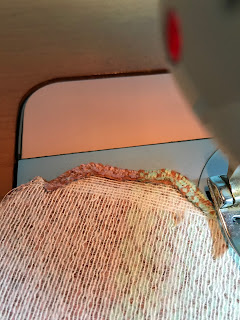 I made our cat Graycie a toy mouse several months ago with a scrap of wool fabric I had left over after making Teddy bears. She loves it and plays with it every day. She always seems to know exactly where it is, even when we can't seem to find it.
I made our cat Graycie a toy mouse several months ago with a scrap of wool fabric I had left over after making Teddy bears. She loves it and plays with it every day. She always seems to know exactly where it is, even when we can't seem to find it.Here is the pattern and instructions, and below will be photos of the steps. Click on the words below for a PDF pattern to print.
Catnip Mouse Pattern
Clips are made at B.
Press under 1/4" and stitch down between B1 and B2.
Mark stitch line
Mark slit positions.
Cut slits 1/4" to 3/8" for ears.
Cut out ears from thin leather scrap.
Fold ear and insert in slit.
Fold fabric so raw slit edges are even.
Zigzag through the ear and the cut fabric edges to secure ear.
It should look like this on the right side.
Cut a 1" strip crosswise from an old t-shirt. About 8" is enough unless you are making more than one mouse.
Stretch the strip until it rolls into a narrow cord.
Stitch the tail at A. I didn't like the red with this mouse, so I found another color.
Fold body in half and stitch to where seam starts to curve.
Fold the body like this, keeping tail centered.
Turn over and stitch on the previously marked line.
It should have a point with a bit of tail poking out.
Turned right side out, it should look like this.
Sew the remainder of the seam, backstitching at B. Keep the tail clear of the seam.
Poke the sewn rear triangle inside and use the tail to help pull the body right side out.
At this point, it looks like a fish with its mouth open.
Stitch catnip bag. I used a piece of old sheet from my stash of rag rug strips.
Stuff the empty bag inside the mouse body.
Use a funnel in the mouth to add the catnip. Poke it in with the eraser end of a pencil.
When full, gather the end and stitch closed. trim the excess fabric from the bag.
Add a couple pieces of cellophane on both sides. I use cracker wrappers because they crackle. Cats like the crunchy sound.
Poke them in with a pencil.
Hand stitch closed with waxed thread, using a ladder stitch.
Done! Now to call my favorite kitty.








































